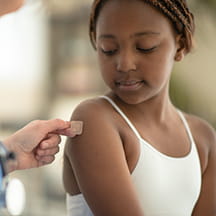Heading into the listening sessions, Megan Smith and her team were bracing themselves. They knew many people in the Idaho communities they were visiting were resistant to the idea of conducting behavioral health surveys with their children and would be vocal in their opposition to those plans in the upcoming meetings.
What Smith couldn’t have predicted, however, was what transpired next.
“It ended with people literally crying and thanking us,” says Smith, Ph.D., director of Communities for Youth and associate professor for the School of Public & Population Health at Boise State University. “I did not expect that gratitude—some of the most originally resistant communities invited us back to do additional conversations.”
The listening sessions were among the first steps in building support for Communities for Youth, a joint effort of St. Luke’s Children’s Hospital and Boise State University to improve youth mental health in Idaho. The program, launched in April 2022, takes an upstream approach to preventing behavioral health issues by addressing their sources and then working closely with the communities to devise solutions.
How it works
Along with the community conversations, the Communities for Youth team uses student surveys as the primary tool to measure overall youth behavioral health and the root causes of any problems. To date, Communities for Youth has conducted about 10,000 student surveys, with plans to nearly double that amount this fall.
Key to the accuracy and impact of the survey results is their hyper-local nature. While most people may know the national and state trends around youth behavioral health—among them, that Idaho's kids have some of the highest rates of depression and suicide in the nation—that these survey results come directly from their kids’ high school helps parents relate to the data.
“It's easy for people to look at the state aggregate data and say, ‘That's not our kids, that’s the community over there,’” says Angie Gribble, senior director of Community Health and Engagement at St. Luke’s Health System in Boise, Idaho. “But when you look at data that truly is your community and realize ‘No, it's our kids and this is what they’ve told us,’—it's harder to ignore that.”
Early intervention
Contributing to the data’s relevancy is how quickly Communities for Youth turns the survey results around: typically within two weeks, according to Smith. From there, the team shares the results with the community and collaborates with its members on how best to structure interventions. Smith says this process is based on the Icelandic Prevention model, a community-based approach where the emphasis is on reaching and mobilizing the parties involved in the immediate vicinity of children.
“It's this beautiful cyclical thing where we're inviting people into the solution and into the hope, because the adults who are looking at this definitely don't want young people to be struggling with mental health,” Smith says. “But it can feel very overwhelming, so our approach is like, ‘Hey, come on in, you're part of the solution—we don’t have to wait for a crisis, you can actually help us start working on it right now.’”
Uniting the state
Communities for Youth is now live—in various stages of its process—in seven school districts across Idaho. By engaging participating communities so deeply in the proceedings, Smith says there’s a sense of ownership that ensures the focus on behavioral health and dedication to solutions won’t easily fade away. While there may always be some who aren’t comfortable with the stigma of meeting youth behavioral care head on, she also knows the ultimate priority for all involved is the welfare of their children.
“We share a core value in Idaho—and I’m sure across the nation—of wanting to help our young people do well,” Smith says. “Even when you're sitting with people who have very different views about mental health and what to do about it, they really do want to come together and work on it.”



